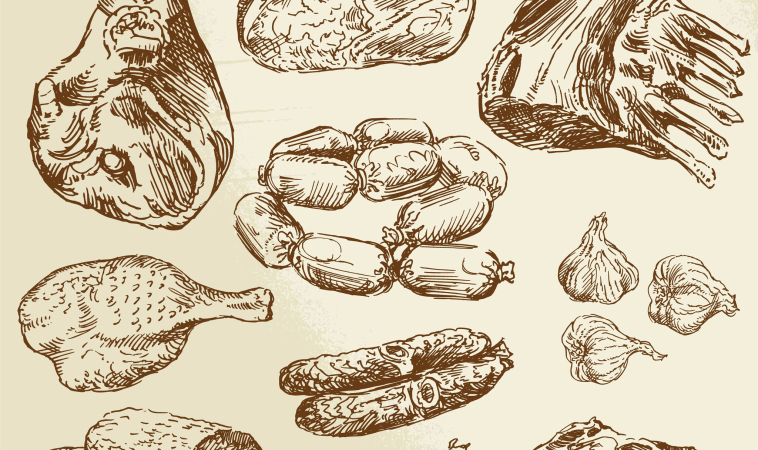Dr. Marc Bubbs ND, CSCS
@DrBubbs
Here are 6 reasons why MORE livestock could be the missing link to feeding the world
As the global population increases year after year, concerns about food availability and climate change have become increasingly real. A common refrain with respect to meat consumption is the enormous amount of water and energy it requires to raise livestock and the negative impacts on the environment (not to mention the notion that it’s impossible to feed the entire planet meat.) Today, 66% of the earth’s landmass is experiencing desertification – when fertile soil is converted to arid and infertile ground – negatively impacting climate change and our ability to feed the world.
However, when you look at the problem from an evolutionary perspective, the movement of large groups of herd animals (i.e. bison in the Americas) has had dramatic and positive impacts on the environment; increasing the nutrient density of the soil, improving the absorption of ground water, and reducing atmospheric carbon, just to name a few. It seems, if we mimic the mass movements and intensive feeding, grazing, and trampling of animals we could exert a very beneficial effect on the environment.
It’s controversial (and seemingly counter-intuitive), but here are 6 reasons why MORE livestock, not less, could be the missing link to feeding the world, reducing climate change, and creating the first truly sustainable and regenerative food agriculture system.
1) Increases The Nutrient Density of the Soil
For millennia giant herds of bison in America or antelopes in Africa roamed the lands and their movement had dramatic impacts on the environment and the health of the soil. The grazed intensely on small areas of grass and plants, and trampled down those areas, before moving on to flee from local predators. After this intense “eating” and “trampling” of the plants, there is tremendous energy put for by the plants into the ground and soil to restore growth. In a traditional agriculture setting the earth is not allowed to “rest” long enough for the plants to grow back, however using ancestral or regenerative farming techniques the land is allowed this period of recovery, dramatically improving the health of the soil and its ability to support plants, insects, bugs and wildlife. Livestock are critical for this process to occur. (Watch biologist Allan Savoury’s TEDx talk.)
2) Improve Water-Retention of Soils
Around the world, two-thirds of the landmass is being transformed into dry desert-like lands, unfit for growing plants and sustaining wildlife. When land becomes sparse (from lack of water, factory-farming draining resources or modern day agriculture techniques) the dead leaves and plants that typically provide cover for bugs, insects and rodents is removed, along with a protective layer on the land that keeps the soil cool and moist. For this reason, even after large rainfalls occur in various regions across the globe the ground does not soak up the water. The rain runs overthe soil, rather than into it. This strongly contributes to desertification of lands and has dramatically negative impacts on the environment (more to come on this in a few paragraphs).
3) Provide Sustainable Fertilizers
The microbiome of the soil is critical for the health of the soil; much like the microbiota of you gut is critical to your optimal health. Manure from livestock is crucial to the health of the bacteria in the soil. Plants and leaves take days to decompose naturally on the soil and if left on their own, can also contribute to desertification. In contrast, livestock ruminants can decompose them in a matter of hours. The greater the amount of plant mass livestock can consume, the more nutrients available to the soil and therefore the greater the potential for growing vegetables. If you want to grow a lot of plants to feed the world, you need a lot of fertilizer. Manure from livestock provides plants with the key nutrients they need for robust growth, and unlike chemical fertilizers, are infinitely sustainable and not harmful to the environment. (Read more why livestock are crucial for sustainability.)
4) Helps Soil Soak Up Carbon
While fossil fuels and environmental pollution no doubt contribute tremendously to climate change, the conversion of fertile grasslands to arid dry lands also plays a major role. When the soil arid and unhealthy, carbon is no longer absorbed by the soil into the ground, but rather released back into the atmosphere. If you consider for a moment that 66% of the world’s landmass is being transformed into desert-like soil, this has a tremendous impact on the carbon levels in the atmosphere, negatively impacting climate change.
Factory farming animals and modern farming techniques are equally harmful, but that doesn’t mean that all techniques are harmful. Regenerative agriculture mimics ancestral herd movements – intensive grazing and trampling of land, followed by a subsequent rest periods for the plants to regrow – that keeps the soil healthy and storescarbon in the ground,removing itfrom the atmosphere. This has the potential to exert a massively beneficial impact on the environment. (Read more about Soil Carbon Cowboys)
5) Help Grow The MOST Vegetables
The healthier the soil, the more nutrients it contains and the more plants you can grow. We could use machines and fertilizers to accomplish this, but they contribute to environmental pollution and are not sustainable. You could also allow plants to decay naturally, but unfortunately this is not sustainable and cannot support enough plant to feed the planet. It also compromises the long-term health of the soil or limits carbon sequestration from the atmosphere. The best way to maximize the growth and sustainable production of vegetables is to use livestock… and lots of them! (Read more about why livestock are necessary for food production)
6) Regenerative Farming Supports Local Farmers
The multi-national corporations that now control a majority of the farming business do not make their money from growing food. They make their money by selling expensive equipment and chemicals to farmers. This puts a lot of money in the pockets of big business, however at the expense of local farmers. A return to ancestral and sustainable farming techniques dramatically reduces the need for herbicides, fungicides and insecticides needed by farmers to maintain their land, as well as the expensive equipment needed to manage traditionally farmed land.
Properly managed livestock and regenerative agriculture not only improves the quality of the soil, but dramatically improves the health of the animals as well. Healthy animals require far fewer antibiotics. The World Health Organization (WHO) has repeatedly issued warnings to reduce the excessive use of antibiotics in livestock, thought to be a root cause of the marked increase in antibiotic resistance. A return to a truly sustainable and regenerative agriculture will help resolve this problem.
In short, farmers have fewer expenses (e.g. equipment and chemicals) and greater profits (e.g. increased demand grass-fed beef and organic produce), which puts more money in farmer’s pocket. Research is currently being done to determine how to scale the successes of small operators and is no doubt solid investment in the future health of our food sources, animals, and the planet. (Read more about regenerative agriculture)
Livestock create the most nutrient-dense soils to grow the most number of vegetables. Livestock help resilient soils soak up atmospheric carbon, reducing the impact on climate change. Regenerative agriculture (requiring numerous livestock) requires far fewer chemicals (e.g. herbicides, pesticides and fungicides) than traditional farming. Eating naturally raised meat supports all of this.
Albert Einstein once said, “You cannot use the same manner of thinking to solve a problem, that you used to create it.” It seems an evolutionary approach to our modern agriculture problems, might just be the revolutionary change we’ve been looking for. In the end, restoring the health of the planet and food chain will be much easier working with Mother Nature, rather than against her.
 Dr. Marc Bubbs, ND is a Naturopathic Doctor, Strength Coach, Speaker, Blogger, and Author of The Paleo Project – A 21st Guide to Looking Leaner, Getting Stronger, & Living Longer. Marc also serves as the Sports Nutrition Lead for the Canadian Men’s National Basketball Team and believes that diet, exercise, and lifestyle factors have the most profound impact on your overall health and performance.
Dr. Marc Bubbs, ND is a Naturopathic Doctor, Strength Coach, Speaker, Blogger, and Author of The Paleo Project – A 21st Guide to Looking Leaner, Getting Stronger, & Living Longer. Marc also serves as the Sports Nutrition Lead for the Canadian Men’s National Basketball Team and believes that diet, exercise, and lifestyle factors have the most profound impact on your overall health and performance.
















